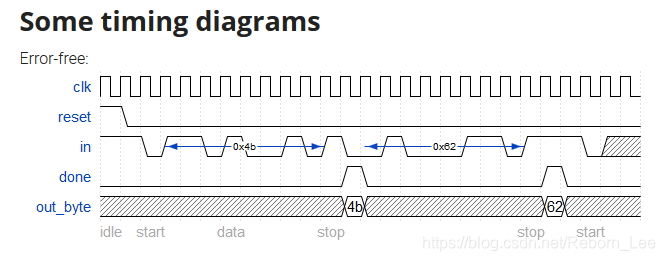HDLBits 系列(31)Serial Receiver and Datapath
【摘要】 目录
序言
原题复现
我的设计
序言
上篇博文:
HDLBits 系列(30)Serial Receiver
写了串行接收器如何接收8位串行数据,正确接收8位串行数据后给一个接收完毕标志信号,这篇博文来继续进一步输出正确接收的串行数据,在done有效时刻输出并行的8bit数据。
特别容易实现,对上篇博客的代码进行略微添加即可。需要注意的是这种uart协议先发...
目录
序言
上篇博文:
写了串行接收器如何接收8位串行数据,正确接收8位串行数据后给一个接收完毕标志信号,这篇博文来继续进一步输出正确接收的串行数据,在done有效时刻输出并行的8bit数据。
特别容易实现,对上篇博客的代码进行略微添加即可。需要注意的是这种uart协议先发送的bit位为低bit位。
原题复现
Now that you have a finite state machine that can identify when bytes are correctly received in a serial bitstream, add a datapath that will output the correctly-received data byte. out_byte needs to be valid when done is 1, and is don't-care otherwise.
Note that the serial protocol sends the least significant bit first.

我的设计
设计如下:
-
module top_module(
-
input clk,
-
input in,
-
input reset, // Synchronous reset
-
output [7:0] out_byte,
-
output done
-
); //
-
-
// Use FSM from Fsm_serial
-
localparam START = 0, B1 = 1, B2 = 2, B3 = 3, B4 = 4, B5 = 5, B6 = 6, B7 = 7, B8 = 8, STOP = 9, DONE0 = 10, DONE1 = 11;
-
reg [3:0] state, next_state;
-
always@(*) begin
-
case(state)
-
START: begin
-
if(in == 0) next_state = B1;
-
else next_state = START;
-
end
-
B1: begin
-
next_state = B2;
-
end
-
B2: begin
-
next_state = B3;
-
end
-
B3: begin
-
next_state = B4;
-
end
-
B4: begin
-
next_state = B5;
-
end
-
B5: begin
-
next_state = B6;
-
end
-
B6: begin
-
next_state = B7;
-
end
-
B7: begin
-
next_state = B8;
-
end
-
B8: begin
-
next_state = STOP;
-
end
-
STOP: begin
-
if(in == 0) next_state = DONE1;
-
else next_state = DONE0;
-
end
-
DONE0: begin
-
if(in == 1) next_state = START;
-
else next_state = B1;
-
end
-
DONE1: begin
-
if(in == 0) next_state = DONE1;
-
else next_state = START;
-
end
-
default: begin
-
next_state = START;
-
end
-
-
endcase
-
end
-
-
always@(posedge clk) begin
-
if(reset) state <= START;
-
else state <= next_state;
-
end
-
-
assign done = (state == DONE0) ? 1 : 0;
-
-
-
// New: Datapath to latch input bits.
-
reg [7:0] out_byte_mid;
-
always@(*) begin
-
case(state)
-
START: begin
-
;
-
end
-
B1: begin
-
out_byte_mid[0] = in;
-
end
-
B2: begin
-
out_byte_mid[1] = in;
-
end
-
B3: begin
-
out_byte_mid[2] = in;
-
end
-
B4: begin
-
out_byte_mid[3] = in;
-
end
-
B5: begin
-
out_byte_mid[4] = in;
-
end
-
B6: begin
-
out_byte_mid[5] = in;
-
end
-
B7: begin
-
out_byte_mid[6] = in;
-
end
-
B8: begin
-
out_byte_mid[7] = in;
-
end
-
STOP: begin
-
;
-
end
-
DONE0: begin
-
;
-
end
-
DONE1: begin
-
;
-
end
-
default: begin
-
;
-
end
-
-
endcase
-
end
-
assign out_byte = (done == 1)? out_byte_mid:'bz;
-
-
endmodule
-
测试成功。
文章来源: reborn.blog.csdn.net,作者:李锐博恩,版权归原作者所有,如需转载,请联系作者。
原文链接:reborn.blog.csdn.net/article/details/103439297
【版权声明】本文为华为云社区用户转载文章,如果您发现本社区中有涉嫌抄袭的内容,欢迎发送邮件进行举报,并提供相关证据,一经查实,本社区将立刻删除涉嫌侵权内容,举报邮箱:
cloudbbs@huaweicloud.com
- 点赞
- 收藏
- 关注作者


评论(0)